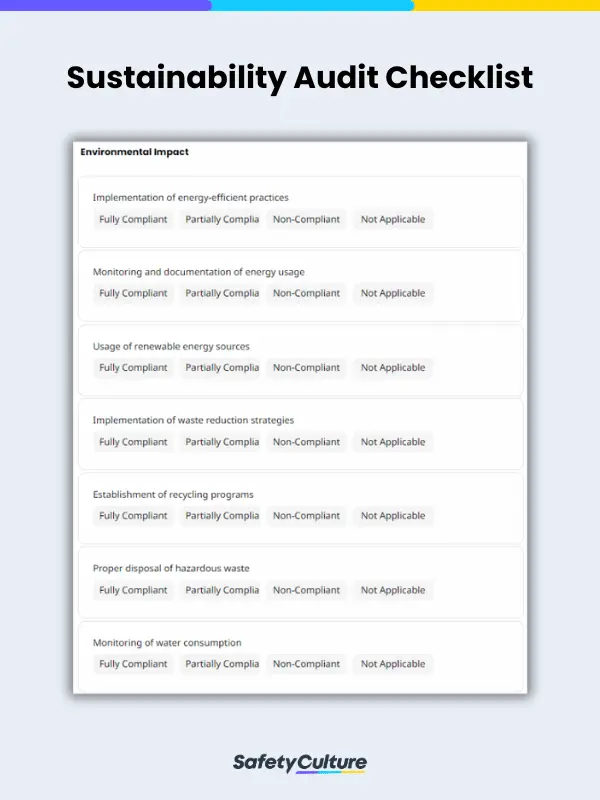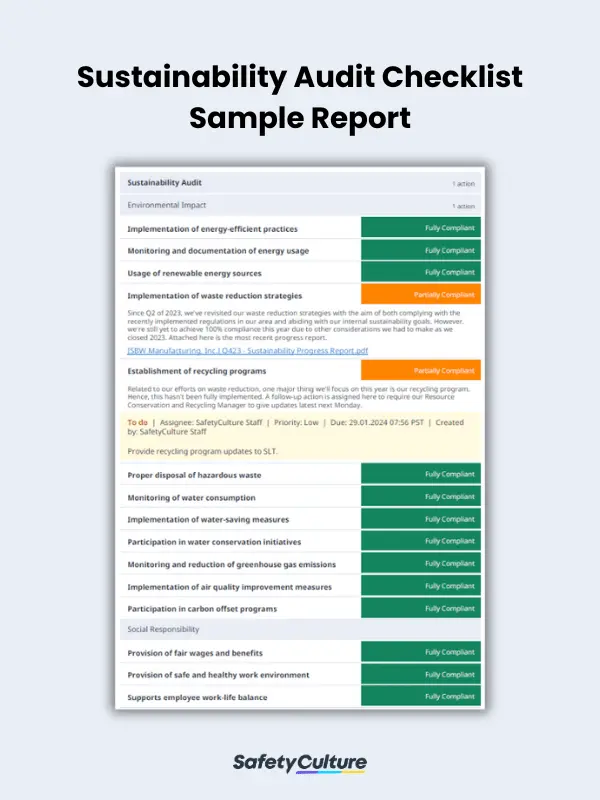What is a Sustainability Audit Checklist?
A sustainability audit checklist is a structured tool used to evaluate an organization’s commitment and adherence to sustainable practices. It comprises a set of items across various aspects designed to comprehensively examine the environmental, social, and economic areas of the organization’s operations. The checklist serves as a guide for conducting thorough self-assessment or third-party audits, allowing businesses to identify improvement actions in sustainability and ensure compliance with established standards and best practices.
Importance of Using a Sustainability Audit Checklist
By providing a systematic framework to measure and enhance sustainability practices, checklists are important tools in ensuring no aspect is left unchecked and unaddressed. By addressing key criteria related to environmental impact, social responsibility, and economic viability, a sustainability audit checklist offers a holistic view of the organization’s sustainability landscape and its practices’ alignment with global standards.
The regular use of the checklist also allows organizations to set sustainability goals, track progress over time, and adapt strategies to meet evolving standards, contributing to long-term environmental stewardship and efficiency gains. This is because conducting sustainability audits using effective tools like checklists helps identify areas for improvement and foster a culture of continuous enhancement.
In an era where stakeholders increasingly prioritize sustainable practices, it’s also notable that using the checklist enables organizations to meet and exceed these expectations. This not only strengthens relationships with customers, investors, and employees but also positions the organization as a responsible and ethical player in the global marketplace.
What to Include in a Checklist for Sustainability Audits
Creating an effective checklist for sustainability audits requires careful consideration of various factors to ensure a comprehensive evaluation of an organization’s environmental, social, and economic practices. Here are key elements to include in this checklist, along with clear and comprehensive sustainability audit questions:
- Title Page
- Environmental Impact
- Social Responsibility
- Economic Viability
- Compliance with Regulations
- Supply Chain Sustainability
- Resource Management
- Stakeholder Engagement
- Innovation and Research
- Risk Assessment and Mitigation
- Performance Metrics and Reporting
- Employee Training and Awareness
- Certifications and Recognitions
- Lifecycle Assessment
- Adaptation to Climate Change
- Continuous Improvement Plans
- Completion Page
How to Conduct a Sustainability Audit Using a Checklist
Conducting a sustainability audit using a checklist involves a systematic and thorough assessment of an organization’s environmental, social, and economic practices. Follow these steps to effectively audit sustainability efforts:
- Create a sustainability audit checklist tailored to the organization’s industry, size, and specific sustainability goals, covering key aspects mentioned in the previous section.
- Form a multidisciplinary audit team with members possessing expertise in environmental management, social responsibility, and business operations and appoint individuals or a main auditor to lead specific sections of the checklist.
- Gather data related to the organization’s sustainability indicators. Make sure to collect supporting documentation, such as financial reports, employee records, and evidence of compliance with relevant regulations.
- Visit relevant sites within the organization to observe operations, assess environmental practices, and gain insights into sustainability practices.
- Address each item in the checklist, record observations, and add relevant notes to identify areas of strength, weaknesses, and opportunities for improvement in the organization’s sustainability practices.
- Compile the audit findings into a comprehensive report, clearly presenting the assessment results for each section of the checklist. Where necessary, include recommendations for improvement and corrective actions.
- Share the sustainability audit results with relevant stakeholders, such as employees, management, investors, and customers, to highlight the organization’s commitment to transparency and continuous improvement.
- Collaborate with key stakeholders to develop an action plan based on the audit findings.
- Implement the action plan and monitor progress regularly.
- Schedule regular reviews of the sustainability audit checklist to ensure its relevance and update it based on changes in regulations, industry standards, and organizational goals.
Sustainability Audit Checklist Example
It’s also advisable to review how other organizations or entities conduct their sustainability audits and what their reports look like. To guide you, here’s a straightforward example of a sustainability audit checklist when filled out and exported into a report:
FAQs About Sustainability Audit Checklists
Yes, a sustainability audit checklist can be easily customized for various sectors and industries to address unique environmental, social, and economic considerations. Tailoring the checklist also ensures relevance to industry-specific standards, regulations, and sustainable practices. This flexibility allows organizations to align their sustainability assessments with the distinctive challenges and opportunities of their respective sectors.
Yes, aligning sustainability audit checklists with international standards is crucial to ensure consistency, credibility, and a globally recognized framework for assessing sustainable practices.
Adherence to established standards enhances an organization’s credibility and facilitates comparisons with industry benchmarks. It also promotes an understanding of sustainability across borders, supporting broader initiatives for global environmental and social responsibility.
Certainly, a sustainability audit checklist is helpful in proactive risk identification and mitigation. By assessing environmental, social, and economic aspects, organizations can identify vulnerabilities and potential challenges related to sustainability. This proactive approach allows for the development of strategies to mitigate risks, enhancing overall business resilience and long-term sustainability.




